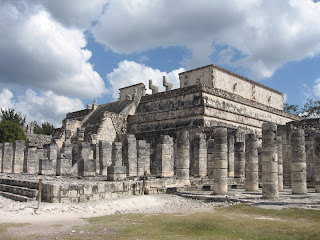Draft page.
Near the entrance to the site the visitor is confronted by the emblematic shape of the Castillo, a massive pyramid topped by the temple of Kukulcan. The structure reflects the Maya calendar with four flights of 91 steps plus one on the top platform making a total of 365. Other numbers represented are the eighteen months of the Maya year and the 52 years of the Meso-American century. On the equinoxes the shadow of the sun undulates down the steps forming a serpentine line which ends with the carved snake heads at the foot of the stairs. It is a spectacle that draws crowds much in the same way as the solstice at Stonehenge. The public are no longer permitted to climb it since several visitors were killed or injured after falling down the steep stairways.
Nearby is the Platform of Eagles and Jaguars, reflecting the two orders of knighthood introduced by the Toltecs. It is thought that they took over Chichen Itza after migrating from Tula in the Valley of Mexico in the tenth century. Certainly many of the features of the two sites are very similar, but Chichen is much bigger than Tula and the influence could well have been in the other direction. The debate continues. The platform is decorated by images of eagles eating human hearts. The destination of the heads of the hapless victims was clear from the adjacent tzompantli or skull rack, another import from the Valley of Mexico with its decoration of row upon row of impaled skulls.
A lighter note is struck by the Temple of the Jaguars with its rather endearing jaguar throne. This backed on to the main ball court of Chichen, a massive arena with stone hoops placed centrally along the two facing vertical walls and the sloping lower levels decorated with gruesome pictures of the fate of the players, whether winners or losers is unclear. They are shown decapitated with blood spurting from their necks.
Others did manage to die a natural death and were buried in low pyramids in the Osorio and surrounding structures. This was in an area where there were also residential structures, including the colonnaded Casa de las Mateles or house of the grindstones, evidently an area where corn was prepared. This is in the older classical part of the city where the dominant structure is the Caracol or snail, so-called from the winding stairway inside the circular tower which was evidently used as an observatory as the windows align to important celestial phenomena.
On the southern edge of the small portion of the whole site that is open to visitors is the building named as Monjas. Like in Uxmal this was named by the Spaniards and it is more likely to have been an administrative building than a nunnery. It is elaborately carved with masks of the rain god Chac in the Chenes style. Nearby is a smaller building in the Puuc syle with the lowest level unadorned, dubbed the Iglesia, or church. Both of these facades were drawn in great detail by Catherwood.
To the north of the site at the end of an old Mayan sacbe or causeway, now lined with people hawking knickknacks, to the formidable cenote or well, a massive natural depression in the limestone where maidens were reputedly cast as sacrifices to the rain god. American archaeologists dredged the well and discovered the bones of men as well as women and many offerings of jade and gold objects, some of which can be seen in the museum in Merida although much has been spirited away to the United States.
The main structure in the Toltec part of the city is the Temple of the Warriors, a stepped pyramid fronted by rows of columns carved with warriors in bas-relief. This is very similar in layout to a temple complex in Tula, and the rows of columns continue ad infinitum in the neighbouring Square of the Thousand Columns which is though to have served as a market area.







































